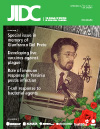2009 Influenza A (H1N1) in Panama: a disease affecting children with a benign course
DOI:
https://doi.org/10.3855/jidc.1495Keywords:
epidemiology, pediatric, 2009 Influenza A (H1N1), PanamaAbstract
Introduction: Pandemic Influenza A (H1N1) was identified as the major febrile respiratory illness worldwide during the year 2009. We present a report of its clinical and epidemiological characteristics in children and adults in Panama.
Methodology: A descriptive study from the database of the Gorgas Memorial Institute is presented. We included patients with severe acute respiratory infection in whom a nasopharyngeal swab was positive by real-time RT-PCR for 2009 Influenza A (H1N1) pandemic virus and negative for seasonal influenza A H1 and H3.
Results: From 26 April 2009 to 11 January 2010, confirmed cases of pandemic 2009 Influenza A (H1N1) reached 806. The overall incident rate was 23.35 cases of pandemic influenza per 100,000 habitants, with the highest incidence found in the age group between 10 to 14 years of age (58.67 cases per 100,000 habitants). The median age for the cases was 13 years (ages ranging from one day to 88 years) and 71% were from the Panama City Metropolitan Area. The male/female ratio was 1:1 and 90% were managed as out-patients. An influenza-like syndrome was the presenting diagnosis in 99% of the cases. Fever and cough were the most frequent symptoms reported in all age groups. The case fatality rate was 0.3 cases per 100,000 habitants.
Conclusion: The 2009 Influenza A (H1N1) outbreak affected mainly the pediatric population, had a low case fatality rate, and was the predominant virus circulating in Panama during the 2009/2010 flu seasonDownloads
Published
How to Cite
Issue
Section
License
Authors who publish with this journal agree to the following terms:
- Authors retain copyright and grant the journal right of first publication with the work simultaneously licensed under a Creative Commons Attribution License that allows others to share the work with an acknowledgement of the work's authorship and initial publication in this journal.
- Authors are able to enter into separate, additional contractual arrangements for the non-exclusive distribution of the journal's published version of the work (e.g., post it to an institutional repository or publish it in a book), with an acknowledgement of its initial publication in this journal.
- Authors are permitted and encouraged to post their work online (e.g., in institutional repositories or on their website) prior to and during the submission process, as it can lead to productive exchanges, as well as earlier and greater citation of published work (See The Effect of Open Access).








